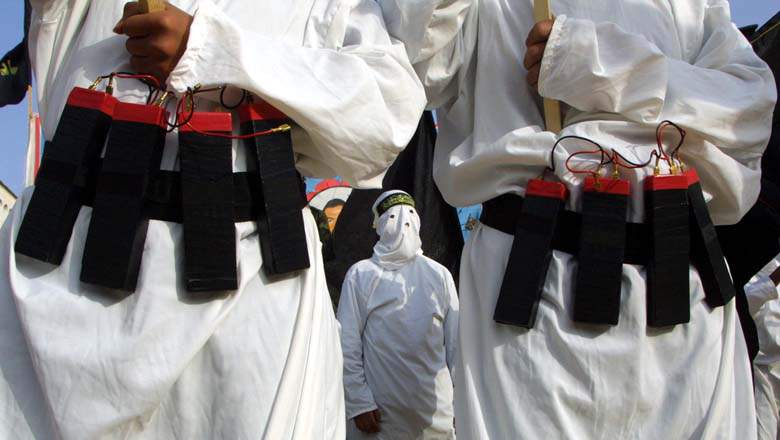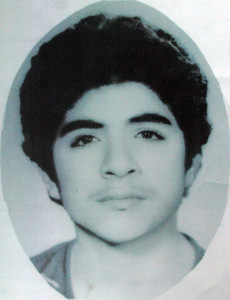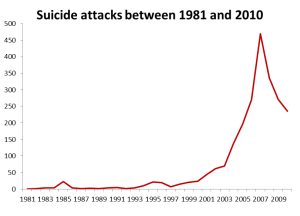Dying to Kill
A brief history and analysis of suicide terrorism

“…We only have to be lucky once. You will have to be lucky always.” – The Irish Republican Army, Irish republican paramilitary group.
In the 20th Century, suicide terrorism was an outlying, exotic tactic used sparsely by a handful of groups. Not to say that bombings, shoot outs, and riots did not exist, but living in fear of a group using suicide bombing in a crowded public space was not something people worried about. Today, from Baghdad to New York, Paris to Abuja, suicide terrorism is a serious threat to civilians and soldiers alike. Suicide bombings were previously used to assassinate politicians, attack military bases and destroy embassies, but now terrorists have begun to also attack civilian targets such as schools, landmarks and places of worship.

Credits: https://flic.kr/p/ajcZYg
The most infamous instance of a suicide attack were the 9/11 bombings in New York and Washington D.C., which resulted in the death of nearly 3,000 people, the bloodiest suicide attack in history. Suicide attacks now account for about 5% of all cases of terrorism but, perhaps even more striking, one third of all casualties since the year 2000 (Andrew Silke, Terrorism). Non-suicide attacks are complicated. Attackers need weapons training, protective equipment and logistical support. Moreover, they face the risk of being captured, tortured and interrogated for valuable information. On the other hand, suicide attacks are relatively simple. Terrorists only require a single devoted grunt willing to simply strap on explosives and blow himself/herself up in broad daylight to take as many lives as possible.
Suicide attackers are usually looked upon as a group of barbaric and deranged individuals who are seeking revenge out of desperation and a thirst for terror. However, these attacks are carefully thought out and well planned by educated professionals. Terrorists are not only farmers and the mentally insane, but also doctors, engineers, former military officers, and mathematicians. The brawn may be the bomb, but the brains are the trigger. The ultimate goal of suicide terrorism is to garner as much media coverage as possible to promote the group’s own religious and political agenda, and spread the most fear and paranoia across the general population.
“…I believe that with my death I shall do all that it is my duty to do, and no one in the world can demand more of me.” – Ignaty Grinevitsky, Principal assassin of Tsar Alexander II (written the night before the assassination)

Contrary to popular belief, the first ever suicide bomber was not a radical Arab jihadist, but actually a Russian mathematics student. The invention of dynamite in 1867 gave terrorists and revolutionaries a weapon that was 20 times more powerful than gunpowder. The People’s Will, a 19th century Russian populist revolutionary movement, used the first ever human trigger of dynamite explosives during the assassination of Tsar Alexander II in 1881. Ignaty Grinevitsky, a mathematics student, ran towards the carriage the Tsar was in and exploded the bomb underneath his feet. Tsar Alexander’s feet were blown off, his stomach ripped out and his face mutilated. He died a few hours later (Radzinky, 2005).
Another inspirational group to modern day terrorists were the Hashashin of the Levant, who were so effective that they became the name sake of the word ‘assassin.’ In the 11th Century, the Hashashins waged a 200 year long terrorism campaign against the Crusaders and Arab kingdoms using suicide attacks and assassinations. Killings were conducted in broad daylight in public view to instill fear into the general public and military forces. Lacking a standing army, terrorist groups like Al-Qaeda and the Tamil Tigers mimicked the Hashashin’s tactics of psychological warfare, subterfuge, guerrilla warfare, and surgical strikes to subdue their enemies in a war of attrition rather than on the battlefield.
The modern age of suicide terrorism formally began in 1983, when an obscure terrorist group called Jihad al-Islami launched a series of suicide attacks and bombings against foreign targets in Beirut, Lebanon. On October 23rd, 1983, Bombers drove trucks filled with explosives into Beirut International Airport, a US Marine’s barracks, and a French military barracks (J.Geraghty, Peacekeepers at War, Beirut 1983). Over 250 U.S and French peacekeepers were killed. It was France’s biggest loss of military personnel since the end of the Algerian War, the deadliest single-day death toll of the US military since the Tet Offensive in Vietnam, and the deadliest single attack on American citizens before the September 11th attacks. These attacks caused Western forces to hastily pull out of the country and abandon the region for years. The success of the 1983 bombings sparked the rise of suicide terrorism in the modern age. Terrorist groups around the world began to adopt the tactic. It may have been originally viewed as extreme, but its inexpensiveness, logistical simplicity, and ability to intimidate the most powerful of military forces to withdraw made it an attractive option for terrorist groups around the world.

Credits: http://bit.ly/2dK1Ftq
“We must die, so let us die bravely.” – Huang Xing, Chinese revolutionary leader and statesman.
Unsurprisingly, terrorist groups and revolutionary groups around the world began to adopt these tactics. Groups such as Al-Qaeda and Hamas shared the same religious orientation as Jihad al-Islami, but many non-Islamist groups also began to use suicide attacks. The Tamil Tigers, a Sri Lankan Tamil nationalist guerrilla movement, extensively used suicide attacks against the Sinhalese Sri Lankan government and even innovated attacks by developing the first ever suicide belt and vest. The Tigers were also responsible for the assassination of ex-Indian Prime Minister Rajiv Gandhi in 1991 when a young female bomber detonated an explosive in her dress. The PKK, a Turkish Marxist group, began to use suicide attacks in the 1990s when they were cornered by the Turkish military. The Black Widows, a terrorist group comprising of widows of dead soldiers from the Chechan Wars (1994-96, 1999-2000), began to use suicide bombings against the Russian government in cities across the country. Their motivation was not primarily religious or ideological, it was pure revenge. During the Xinhai Rebellion (1911-12) in China, “Dare to Die” suicide squads were formed by Chinese student revolutionaries to fight against the Qing Dynasty. The “martyrdom” of the student revolutionaries helped defeat the Qing Dynasty and establish the Chinese Republic in 1912.
However, suicide bombing is not a tactic exclusively used by anarchists and fanatics. In World War 2, the Japanese Imperial forces were infamous for their use of kamikaze airstrikes, in which squadrons would be dedicated solely to crashing into Allied battleships and outposts. During the Second Sino-Japanese War (1937-1945), Chinese forces deployed “suicide squads” against the Japanese military (A. Linebarger, Sun Yat Sen and the Chinese Republic). These suicide squads would run into battle with swords and dozens of grenades strapped to their chests. During the Battle of Berlin, the German Luftwaffe (Air force) flew “self-sacrifice missions” against Soviet controlled bridges on the River Order. The Leonidas Squadron, named after the leader of 300 Spartans who valiantly attempted to defend Greece in the Battle of Thermopylae, supposedly destroyed dozens of bridges to Berlin, slowing the inevitable Soviet advance (A. Beevor, Berlin: The Downfall).
“There is no moral difference between a Stealth bomber and a suicide bomber. They both kill innocent people for political reasons.” – Tony Benn, UK member of parliament

Credits: https://flic.kr/p/2NaKu
Robert Pape, founder of University of Chicago’s “Chicago Project on Security and Terrorism,” believes that the reason for suicide bombings is not for religious reasons but more so done to expel an occupying foreign force or to prevent/protesting any changes made to the sociological structure of civil society. Pape stated that “the presence of American military forces for combat operations on the homeland territory of the suicide terrorists is stronger than Islamic fundamentalism in predicting whether individuals from that country will become al-Qaeda suicide terrorists” (Pape, Dying to Win).
Today, suicide attack targets have been chosen based on factors besides religion. Ethnicity, ideology, sect, and national identity are all contributing factors. Levantine Sunni terrorists frequently destroy Shiite mosques, Tamil bombers in Sri Lanka routinely ravage Sinhalese city districts, and Marxists in Turkey bomb airports and police stations in opposition to Erdogan’s “neo-Ottoman” regime. Many former Sunni Ba’athist officers formed and joined terrorist groups in Iraq and Syria after the US occupation, especially after the formerly oppressed Shiites were given power. American De-Ba’athification of the Iraqi government and military resulted in widespread repression and open rebellion by the former ruling Sunni minority. ISIS’s head of intelligence, second in command, chief spokesperson, and many senior officials were all within the secularist Sunni Iraqi intelligence service or officers in the Iraqi army.

Credits: http://bit.ly/2eS64Yv
Suicide attacks are not a new phenomenon brought about only by the rise of Islamic fundamentalism. Mark Juergensmeyer, an American sociologist who specializes in religious violence, once said “…religion is not innocent. But it does not ordinarily lead to violence. That happens only with the coalescence of a peculiar set of circumstances – political, social, and ideological – when religion becomes fused with violent expressions of social aspirations, personal pride, and movements for political change” (M. Jeurgensmeyer, Terror in the Mind of God). Recently, while there has been much malaise towards Islam after the September 11th attacks, one doesn’t need to draw upon the Quran alone to justify suicide attacks. The Old Testament and most religious texts, in general, have accounts of individuals sacrificing themselves to kill their enemies in an act of self-redemption rather than cowardice. A notable example is of the hero Samson (Judges 16:30). A captured Samson sacrificed himself in order to wipe out a hall full of Philistines.
There is undeniable evidence that in recent years there has been a link between Islam fundamentalism and suicide terrorism. Charismatic leaders who have or are perceived to have religious authority and expertise have convinced many that martyrdom operations are permissible in Islam despite condemnation of suicide in the Quran. The concept of martyrdom has been used by terrorist groups as a tool for recruitment, and a means of helping bombers overcome their fear of death and reluctance to kill innocents. Potential bombers are mesmerized by the thought of a “glorious death,” the “rewards of heaven,” and “contributing to the jihad.” Despite claims of religious authority, captured or investigated ISIS operatives have proven to be fairly ignorant about Islam. Bombers have been documented to have owned copies of “Islam for dummies“. Other bombers were discovered to have sold illegal substances to students, had history of domestic abuse, and didn’t even practice Islam regularly. The leader of the 9/11 attackers, Mohammad Atta, was a party animal, regularly snorted cocaine, drank alcohol, and ate pork chops. Not the usual description of a practicing Muslim, let alone a “holy warrior.”
The first ever instance of a modern “martyrdom operation” was during the Iran-Iraq War (1980-88). Mohammad Fahmideh, a 13 year old Iranian child soldier, strapped grenades to his chest and blew up an Iraqi tank by diving under it. The Iraqi advance into the besieged city of Khorramshahr was halted as they believed the surrounding area was mined, and as a result Fahmideh was proclaimed a war hero and martyr by Ayatollah Khomeini and helped inspire many young Iranians to join the fight. Almost every major culture shows a glorification of martyrdom. People and groups who resist against perceived tyrants, facing improbable odds, and almost certain death are always heralded as icons of bravery and pride. Today, blockbuster movies have been made about the 300 Spartans who valiantly defended against an army of 250,000 Persians at the Battle of Thermopylae in 480 BCE. It is undeniable that religion does play a role in terrorism, but it is primarily in the context of national struggles and geopolitics. However, the dynamics of religious difference do matter. After all, it is nothing new for terrorist groups to use religion as a source of automatic legitimacy for their actions and as a recruitment tool. ISIS has declared itself an Islamic Caliphate in the Levant, the Lord Resistance Army’s constitution is the 10 Commandments of God, and Aum Shinrikyo in Japan prophesies of Armageddon based on Hinduism and Buddhism.
“Our words are dead until we give them life with our blood.” – Mohammad Sidique Khan, leader of the 7 July 2005 London bombings.
A terrorist doesn’t wake up one day and think to himself “I’m going to blow myself up today!” The decision to carry out a suicide attack is not quick one. It is a slow process, where at least one member of the terrorist cell will go abroad for a 6 month training program prior to the attack (A.Silke, Terrorism). This program usually involves attaining the skills and logistical knowledge to conduct an attack and picking targets which will spark the most media attention and generate nationwide (if not worldwide) fear. For many bombers, the choice of carrying out a suicide attack is the most important decision they will make in their entire lives. As a result, in the run up to the attack, many would naturally have second thoughts. Many ask for reassurance that the purpose is righteous and question if they should follow through, as it is forbidden to commit suicide. To counteract claims of encouraging sin by performing suicide bombings, religious orientated/nationalist terrorist groups such as Al-Qaeda and PKK renamed suicide attacks to “martyrdom operations.” Rather than emphasizing “victimization” of the attack, it’s been used to emphasize the heroic task the bomber has undertaken and selfless act of sacrifice.

Credits: http://bit.ly/2eHoVHS
Terrorist groups have set up rituals that provide a framework to encourage terrorism attacks and make sure bombers don’t back out of their duty. Rituals provide important psychological landmarks for terrorists, essentially peer pressuring bombers into carrying out the attack by performing rituals such as releasing videos proclaiming their support for the cause, condemning the enemy and explaining the legitimacy of their actions. In some groups, the bombers are later permanently referred to as “living martyrs,” meaning the person has already died and is only temporarily in this world. By this stage, few back out. Suicide terrorism is a form of psychological warfare where its main goal is to cause panic and paranoia among populaces and law enforcement, as well as communicating to moderates and sympathizers through widespread media attention. By making their intentions public knowledge, the bomber has not only fulfilled a propaganda role but also now essentially locked themselves into carrying out the attack. By utilizing peer pressure, terrorist groups are able to effectively force an individual to kill themselves or risk losing face.
“Democratic nations must try to find ways to starve the terrorist and the hijacker of the oxygen of publicity on which they depend.” – Margaret Thatcher, UK Prime Minister
It’s not all doom and gloom when it comes to combating suicide terrorism. Law enforcement professionals have worked towards detecting and preventing such attacks by using superior chemical detectors and radar scanners to identify hazardous materials and electronics. However, the high costs of such equipment will prevent widespread application. Areas such as Afghanistan and Syria lack the technological expertise and resources to carry out widespread manufacture and distribution of such devices. Moreover, corruption within law enforcement and the military can allow terrorists to adjust strategies and bomb production.
Defense Advanced Research Projects Agency (DARPA), the Pentagon’s research branch, convened a panel of homeland security experts and scientists to figure out how to stop suicide bombings and prevent casualties. One of the ideas the panels had was “detection by detonation.” Under this plan, military personnel at checkpoints would release radioactive rays onto cars. The car would be able to pass safely unless there was a bomb within, in which case the beam would cause the car to explode, killing everyone on board. It’s not very practical, due to the danger of unintentionally killing civilians and soldiers, as well as potentially causing a chain explosion with cars in line.

Israeli settlers have suggested that the remains of the bombers be drenched in pigs blood in order to discourage would be bombers from partaking in “martyrdom.” However, not all terrorists are motivated by religion and not all terrorists are Muslim. Terrorists witnessing the dehumanization of the remains of lost compatriots will only be encouraged to use force more frequently and with greater vindication.
Terrorists have begun to innovate. Besides hiding bombs in unusual places and using remote detonation, terrorist groups have begun to develop and sparsely use cavity bombs, which are surgically inserted into the bombers body. According to the Daily Mirror, MI6 agents asserted that female suicide bombers would surgically insert explosives (known as body cavity bombs) into their breasts in order to prevent detection, and then detonate the explosives with a chemical trigger. A high profile example of a cavity bomb was the assassination attempt of then Saudi Interior Minister, Crown Prince Mohammad Bin Nayef. The bomber absorbed most of the blast and Bin Nayef escaped with a few minor injuries (R. Bunker, C. Flaherty, Body Cavity Bombers: The New Martyrs).
“From pacifist to terrorist, each person condemns violence – and then adds one cherished case in which it may be justified.” – Gloria Steinem, American journalist and political activist.
Terrorism’s quest for world domination is pure fantasy, but increasing attempts at forcibly installing Western “puppet” governments have resulted in nationalist revolutions and insurgencies that have given birth to even more xenophobic and barbaric regimes. The overthrow of the US backed Shah of Iran resulted in an unpredictable Islamic Republic, the Taliban has resurfaced because of the incompetence of the Afghan government, and the West’s installation of Shiite rule over historically Sunni land gave birth to ISIS.
Is there a future where suicide bombs will run out of fashion? In my opinion, no. Suicide attacks are far too effective for terrorist groups and militaries to give them up. The tactics ability to bypass so many conventional defenses and security measures untested makes it far too attractive an option for groups to use, especially to smaller groups which are withering in strength and need to utilize terror doctrines and psychological warfare to remain relevant. Ultimately, suicide attacks can happen anywhere and at any time. Robert Pape believes that the states should define victory as destroying current terrorist pools to prevent a new generation from being recruited, but it is too late to do so in Afghanistan, Pakistan, Syria, Iraq, and Lebanon, where many young children and adults have lived through constant violence and among fighters for their entire lives. Many of these children have seen family members join and fight for Islamic groups, they have been taught to use weapons and encouraged to become suicide bombers. There is little chance that the world will ever be rid of suicide bombings and no region or country will ever be immune from risk. After all, they only have to be lucky once; we have to be lucky always.
